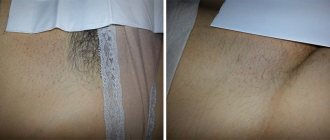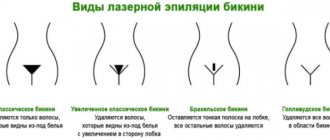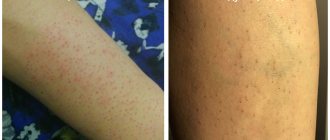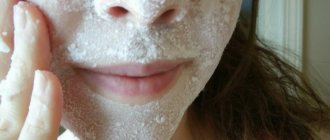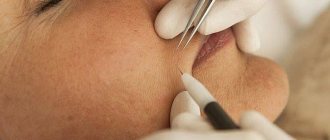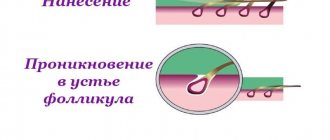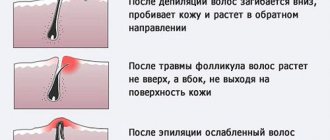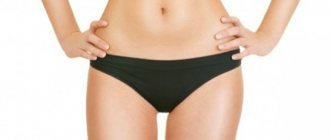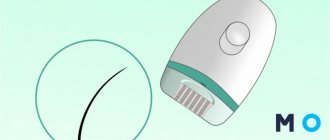What is electrolysis?
Electrolysis is a method of getting rid of body hair, which was discovered back in the 40s of the twentieth century. Its essence lies in the fact that, using a short thin needle, a specialist directs an electric discharge to the very root of the hair and thus destroys the structure of the hair bulb. The hair becomes weak and then falls out.
It is interesting to note that officially electrolysis is the only way to permanently remove hair .
The American organization Food and Drug Administration, which monitors medical procedures, has allowed the appropriate mark to be placed only for electrolysis.
Skin care after electrolysis
- Do not wet the treated area during the day.
- Treat the skin area twice a day, first with chlorhexidine, then with cindol.
- Do not touch the epilated area with unwashed hands.
- Do not apply creams and deodorants to your body (otherwise you will create a favorable environment for the development of bacteria)
- It is not advisable to apply cosmetics (foundation, lipstick, powder) to the face within 24 hours after the procedure.
- It is strictly forbidden to sunbathe and take sunbathing until the crusts are completely healed, otherwise age spots may form.
- It is forbidden to play sports, visit the sauna, take a hot shower, or swim in chlorinated water in the first week after the procedure.
- It is advisable to wear looser clothing to avoid irritation
These simple rules will help avoid skin irritation, speed up its healing and prevent the appearance of folliculitis.
How is electrolysis performed?
A professional cosmetologist knows that the electrolysis procedure is quite painful. Therefore, our cosmetologist will offer you options for painkillers, taking into account your individual tolerance to the drugs. Then the hair removal procedure itself begins.
Needles for electrolysis are sterile and very thin. They are introduced to a depth of 1 to 5 mm, depending on the treated area. The needle delivers an electrical discharge to the hair follicle, the follicle is destroyed, and the hair itself is removed using tweezers.
After the procedure, you cannot visit the bathhouse, sauna, swimming pool or solarium for a week. Redness and slight swelling may occur.
Prices for electrolysis at the World of Beauty salon
What are the consequences of electrolysis?
If the electrolysis procedure is carried out correctly and post-procedure care is followed, there will be no unpleasant consequences on the body. Burns and scars are a result of a novice specialist lacking the necessary experience and/or performing the procedure on a budget device at home.
Skin after electrolysis
A common skin reaction immediately after electrolysis is redness and swelling, all of which goes away within a few hours after the procedure.
Red dots (crusts) after electrolysis
Further, red dots remain at the site of the removed hair; in their place, after 2 days, barely noticeable crusts form, which dry out and fall off after about 2 weeks.
Where can you remove hair using electrolysis?
Electrolysis removes hair from both the body and face. It is important to remember that there are time limits that you need to find out about from a specialist.
For example, the area above the upper lip cannot be treated for more than 10 minutes at a time.
IMPORTANT: you cannot remove hair from the ears and nose using electrolysis; you should be careful when approaching this type of hair removal in the armpit area.
A professional cosmetologist performs the procedure quickly enough. However, you cannot choose speed at the expense of quality!
Contraindications to electrolysis
Since electrolysis is the work of a specialist with the skin, the main contraindications are related to diseases or damage to the skin:
- Inflammatory processes in the skin, including viral ones
- Acute and chronic skin diseases
- Malignant neoplasms of the skin
- Varicose veins (if the procedure is performed on the legs)
- Tendency to form scars (keloid disease)
There are also other restrictions:
- Diseases of the heart and blood vessels, including stroke and myocardial infarction
- Presence of all types of tumors
- Endocrine system diseases
- Mental disorders and epilepsy
- Intrauterine device (if the procedure is on the bikini area)
- Pregnancy (breastfeeding)
- Individual intolerance to metals and their alloys
- Presence of a pacemaker
- Severe forms of hypertension and coronary heart disease
- Diabetes
- Asthma
- Infectious diseases (Hepatitis, HIV, etc.)
Consequences and side effects
Scars are the result of burns after electrolysis, the treatment of which depends on your subsequent skin care. This problem may arise if the specialist has set the electric current values too high for you .
Here you can take into account factors such as the doctor’s ability to correctly perform the procedure and the body’s tendency to form scars. Important !
If the consequences in the form of burns or scars after trying electrolysis appear to a fairly strong degree and do not go away for a long time, then it is better to abandon the procedure and replace it with another type of hair removal. The recovery process will also depend on the individual characteristics of the body.
Treatment consists of using various ointments to heal burns:
- "Panthenol";
- "Levomekol";
- "Dermazin".
Often cosmetologists themselves prescribe drugs and procedures to treat the following consequences:
- Small red dots scattered throughout the needle impact area are a normal reaction after electrolysis; they should disappear on their own after some time . Usually this is two weeks, but some people still have white spots that will also go away. Along with the points, most likely, in the first hours after the procedure, irritation or swelling in the affected area will appear. Itching may occur.
- Pigmentation, marks and spots. If after electrolysis you have red dots that do not go away for various reasons, they can grow and become darker. A common cause of enlargement and brown coloration is insufficient care after the procedure. Unfortunately, it is already more difficult to fight them.
Did you know? With the help of the ELOS method, not only pigmentation disappears, but also the skin becomes tightened, acne and unwanted hair disappear.
This procedure helps rejuvenate the skin. There are different ways, depending on the degree of pigmentation and your individual skin characteristics, how to get rid of spots after electrolysis:
- Try using whitening cosmetics or natural products , such as lemon juice. Choose natural anti-spot products that contain an enzyme such as melanozyme, which can remove pigmentation without consequences.
- Bodyaga also has the same bleaching properties, but stimulates hair growth.
- You can overcome pigmentation after electrolysis using chemical peeling with fruit acids both at home and in a cosmetic center, where experienced specialists will help you remove stains without any consequences.
Don’t forget that you can always go to a salon, where they will advise you on a safer method of getting rid of age spots.
Itching. If it is mild, then there is no need to panic, because this is a completely normal skin reaction to irritation.
If after some time you begin to feel that the itching after electrolysis has become unbearable, then under no circumstances should you comb this area. Note! For the first procedure, you buy yourself a needle, with which the doctor will do hair removal only for you throughout the entire course.
He must regularly disinfect it and store it in a protected place. At your request, between procedures, the needle can be with you. To make it subside, you need to anoint the area with special creams, which can be recommended by an hair removal specialist. Most often this is a chlorhexidine solution. You can immediately lubricate the skin area with it. After a while, it should be treated with a mixture of Trichopoloma and calendula tincture.
If you start intensively scratching your skin, you will earn yourself scars and scars , after which the electrolysis procedure will seem like the biggest mistake to you.
Also, as a preventive measure, you should not take bath procedures immediately after hair removal, and avoid the gym and sunbathing. This will help avoid itching.
Swelling and bruising. Most often, swelling appears after electrolysis in the bikini area or on the face. It is these areas that are very painful, and they are pre-treated with a local anesthetic, most often Lidocaine. This happens due to very sensitive skin in these areas.
Sometimes, patients are allergic to Lidocaine, which also causes swelling. A reaction may appear after the procedure is completed. Swelling in the eyebrows, upper and lower lips - all this is normal if the swelling goes away after three days. Otherwise, you should immediately consult a doctor.
If it is an allergy, then you will be prescribed tablets and, possibly, local ointments or tinctures. In order to relieve swelling immediately after the procedure, you need to wipe the area with calendula tincture. To get rid of germs or bacteria, you can use baby powder.
Bruises appear when blood vessels and capillaries are located very close to the skin . The doctor may touch them when piercing them with a needle. If they do not go away for a long time, then you can use special ointments. But before that, it is better to consult your hair removal specialist.
Pimples and sores. After red dots appear, it is better to smear the skin with calendula or Panthenol. This way you can speed up the healing process of the burn. The sores will soon begin to disappear, the skin should become normal color.
But if you tend to take a long time to heal your wounds, don't be alarmed if those red dots continue to bother you for a while.
In order for them to go away as quickly as possible, you need to contact your doctor, who will recommend an ointment that is suitable for you.
Often, clients complain that after electrolysis they have ulcers. This is not the most pleasant sight. This can happen for several reasons:
- lack of hygiene during the procedure itself;
- very thin skin exposed to aggressive electric current and needles;
- very rough skin, which inhibits the growth of new hair and clogs the sebaceous ducts;
- allergies to electric current or hygiene products.
To avoid the appearance of white pimples, you need to ensure that the doctor’s skin and hands are completely disinfected . You can use different ointments, including Panthenol and Levomekol. But it is better to consult a doctor who will write a prescription for treatment and prevention depending on your skin type.
Some people also experience ingrown hairs after electrolysis. The reason for this behavior of the hair is its incorrect or disturbed growth.
If before the procedure you did hair removal using different methods: wax, sugar or a machine, then most likely your hairs have already disrupted the direction of growth. To get rid of this problem, you can take a warm bath and then lightly pry the hair closer to the place where it grows with a needle , which must be wiped with alcohol.
Crust. When the puncture site heals, it will become covered with a crust. It cannot be scratched. It protects the site from infection and speeds up the wound healing process.
Therefore, be patient and wait for the red spots to go away on their own and the skin to return to its healthy state.
Radiofrequency electrolysis: advantages of the technique
The new device DEPIL PLUS 13MHz combines 2 complementary mechanisms of action:
- electrolysis (the hair root is destroyed by alkali and galvanic current);
- thermolysis (using radio frequency, tissues are heated to a temperature sufficient to cauterize the hair follicle).
As a result of simultaneous chemical and thermal effects on each hair follicle, the desired result is achieved much faster, and the risk of complications is practically eliminated!
Variety of indications for electrolysis
Radiofrequency electrolysis using the DEPIL PLUS 13MHz device can permanently remove hair:
- any location (except for the auditory canals and nasal passages);
- any color and thickness (light, gray, red, black; fluff, guard, etc.);
- on skin of any color (naturally dark, white with freckles and pigment spots, etc.).
Thus, unlike light hair removal methods, radiofrequency electrolysis has certain advantages and is guaranteed to remove hair that is resistant (insensitive) to other hair removal methods!
Safe and virtually painless
The new device for radiofrequency electrolysis has a unique system for automatic control of the entire hair removal process, and the use of a frequency of 13 MHz has made electrolysis almost painless!
However, the radiofrequency electrolysis procedure can only be performed by a cosmetologist with specialization in this technique and experience, because The aesthetic result largely depends on his skill, jewelry precision and professionalism!
Preparation
If you decide to remove hair this way, keep in mind that electrolysis is effective only at the stage of growing hair. That is, the length of the hairs must be at least 2.5 mm. The longer they are, the easier it is for the electrologist to get into the follicle. Therefore, for some time you need to abandon all methods of hair removal.
Before the session, you can cleanse your body with a scrub. It will exfoliate dead skin particles and cleanse the pores where the follicles are located. A shower or hot bath won't hurt either, since the next time you won't be able to wash yourself completely is at least a week later.
If you do not want to undergo injection anesthesia, two hours before the procedure, apply an anesthetic cream recommended by a cosmetologist to the desired areas of the body.
Before electrolysis, you can clean your body with a scrub.
Carrying out the procedure
Before the session begins, the skin in the treatment area is wiped with an antiseptic and numbed. The manipulation is performed with a disposable needle, which the doctor unseals before the start of the session. A neutral electrode is placed in the patient's hand, the doctor inserts a thin needle into the follicle and sends an electrical impulse into it.
The insertion of the needle is practically not felt; pain occurs only at the moment the current is turned on.
On average, the processing speed ranges from 5 to 15 hairs per minute. It depends on the device used and the experience of the cosmetologist. His task is to correctly evaluate and select the appropriate method and current parameters.
The pain does not appear at the moment of needle insertion, but during the application of current
After electrolysis is completed, the skin is again treated with an antiseptic solution and a healing cream with an antibiotic.
Indications for the electrolysis procedure
As a rule, the main indication for hair removal (i.e. permanent removal of hair from the body and face) is the desire of the patient himself, who is tired of regular hair removal (plucking, shaving, waxing, etc.). However, it is possible that the reason for seeking help from a cosmetologist with this aesthetic defect may also be a disease (hypertrichosis, hirsutism). In this case, hair removal is carried out in parallel with treatment by an endocrinologist, gynecologist, etc.
